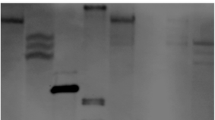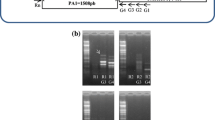Abstract
A chimeric gene consisting of the β-glucuronidase (gusA) reporter gene under the control of the metallothionein-like promoter cgMT1 from the tropical tree Casuarina glauca was introduced into Nicotiana tabacum via Agrobacterium tumefaciens and into Oryza sativa by particle bombardment. The strongest histochemical staining for GUS activity was observed in the root system of the transgenic plants, and especially in lateral roots. In contrast, a relatively low level of reporter gene expression was seen in the aerial tissues and GUS staining was located mainly in the plant vascular system. The average ratio of GUS activity between root and leaf was found to be 13:1 in tobacco and 1.5:1 in rice. The pattern of cgMT1 promoter activity in floral organs was found to be different in tobacco and rice. High levels of gusA gene expression were detected in the ovules, pollen grains and tapetum, whereas in rice PcgMT1 directs expression to the vascular system of the floral organs. These results suggest that PcgMT1 is potentially useful in molecular breeding to express genes of interest whose products are preferentially needed in roots.
Similar content being viewed by others
References
Ahuja MR (2000) Genetic engineering of forest trees. In: Jain MS and Minocha SC (eds), Molecular Biology of Woody Plants. Vol. 1 (pp. 31–50) Kluwer Academic Publishers.
An G (1987) Binary Ti vectors for plant transformation and promoter analysis. Method Enzymol 153: 292–305.
Baker DD and Mullin BC (1992) Actinorhizal symbioses. In: Schwintzer CR and Tjepkema JD (eds), Biological Nitrogen Fixation. (pp. 281–297) Academic Press, New York.
Bradford MM (1976) A rapid and sensitive method for the quanti-fication of microgram quantities of protein utilizing the principle of protein-dye binding. Anal Biochem 72: 248–254.
Charbonnel-Campaa L, Lauga B and Combes D (2000) Isolation of a type 2 metallothionein-like gene preferentially expressed in the tapetum in Zea mays. Gene 254: 199–208.
Chen L, Zhang S, Beachy R and Fauquet C (1998) A protocol for consistent, large-scale production of fertile transgenic rice plants. Plant Cell Rep 18: 25–31.
de Miranda JR, Thomas MA, Thurman DA and Tomsett AB (1990) Metallothionein genes from the flowering plant Mimulus gutatus. FEBS Lett 260: 277–280.
Diem HG and Dommergues YD (1990) Current and potential uses and management of Casuarinaceae in the tropics and subtropics. In: Schwintzer CR and Tjepkema JD (eds), The Biology of Frankia and Actinorhizal Plants. (pp. 317–342) Academic Press, New York.
Fordham-Skelton AP, Lilley C, Urwin PE and Robinson NJ (1997) GUS expression in Arabidopsis directed by 5_ regions of the pea metallothionein-like gene PsMTA. Plant Mol Biol 34: 659–668.
Franche C, Diouf D, Le QV, N'Diaye A, Gherbi H, Bogusz D et al. (1997) Genetic transformation of the actinorhizal tree Allocasuarina verticillata by Agrobacterium tumefaciens. Plant J 11: 897–904.
Franche C, Laplaze L, Duhoux E and Bogusz D (1998) Actinorhizal symbioses: recent advances in plant molecular and genetic transformation studies. Crit Rev Plant Sci 17: 1–28.
Gabe M (1968) Techniques Histologiques. Masson, Paris, 1113 p.
Hamer DH (1986) Metallothioneins. Annu Rev Biochem 55: 913–951.
Horsch RB, Fry JE, Horrman NL, Eicholts, Rogers SG and Fraley RT (1985) A simple and general method for transferring genes into plants. Science 227: 1229–1231.
Jefferson RA, Kavanagh TA and Bevan MW (1987) GUS fusion: ?'-glucuronidase as a sensitive and versatile gene fusion marker in higher plants. EMBO J 6: 3901–3907.
Jouanin L and Pilate G (1997) Gene expression studies. In: Klopfenstein NB, Chun YB, Kim MS and Ahuja MR (eds), Micropropagation, Genetic Engineering, and Molecular Biology of Populus. (pp. 65–69), Gen. Tech. Rep. RM-GTR-297, Fort Collins, CO: US Department of Agriculture, Forest Service, Rocky Mountains Research Station.
Kagi JHR (1991) Overview of metallothionein. Method Enzymol 205: 613–626.
Kay R, Chan A, Daly M and McPherson J (1987) Duplication of CaMV35S promoter sequences creates a strong enhancer for plant genes. Science 236: 1299–1302.
Laplaze L, Gherbi H, Duhoux E, Pawlowski K, Auguy F, Guermache F et al. (2002) Symbiotic and nonsymbiotic expression of cgMT1, a metallothionein-like gene from the actinorhizal tree Casuarina glauca. Plant Mol Biol 49: 81–92.
Matzke MA and Matzke AJM (1995) How and why do plant inactivate homologous (trans)genes? Plant Physiol 107: 679–685.
McElroy D, Blowers AD, Jenes B and Wu R (1991) Construction of expression vectors based on the rice actin 1 (Act1) 5' region for use in monocot transformation. Mol Gen Genet 231: 150–160.
Merkle SA and Dean JFD (2000) Forest tree biotechnology. Curr Opin Biotech 11: 298–302.
Mullin BC and Dobritsa SV (1996) Molecular analysis of actinorhizal symbiotic systems: progress to date. Plant Soil 186: 9–20.
Murashige T and Skoog F (1962) A revised medium for rapid growth and bioassays with tobacco tissue cultures. Physiol Plant 15: 473–497.
Murphy A and Taiz L (1995) Comparison of metallothionein gene expression and nonprotein thiols in ten Arabidopsis ecotypes. Plant Physiol 109: 945–954.
National Research Council (1984) Casuarinas: Nitrogen Fixing Trees for Adverse Sites. National Academy Press, Washington, DC.
Pawlowski K and Bisseling T (1996) Rhizobial and actinorhizal symbioses: what are the shared features? Plant Cell 6: 1899–1913.
Rauser E (1999) Structure and function of metal chelators produced by plants. In: Cell Biochemistry and Biophysics. Vol. 31 (p. 19–48) Humana Press Inc.
Robinson NJ, Tommey AM, Kuske C and Jackson PJ (1993) Plant metallothioneins. Biochem J 295: 1–10.
Rogers SG, Horsch RB and Fraley RT (1986) Gene transfer in plants: production of transformed plants using Ti plasmid vectors. Method Enzymol 118: 627–640.
Vancanneyt G, Schmidt R, O'Connor-Sanchez A, Willmitzer L and Rocha-Sosa M (1990) Construction of an intron-containing marker gene: splicing of the intron in transgenic plants and its use in monitoring early events in Agrobacteriummediated plant transformation. Mol Gen Genet 220: 245–250.
Wall LG (2000) The actinorhizal symbiosis. J Plant Growth Regul 19: 167–182.
Zhang W, McElroy D and Wu R (1991) Analysis of rice Act1 5_ region activity in transgenic rice plants. Plant Cell 3: 1155–1165.
Zhou J and Goldsbrough PB (1995) Structure, organization and expression of the metalothionein gene family in Arabidopsis. Mol Gen Genet 248: 318–328.
Author information
Authors and Affiliations
Corresponding author
Rights and permissions
About this article
Cite this article
Ahmadi, N., Dellerme, S., Laplaze, L. et al. The Promoter of a Metallothionein-Like Gene from the Tropical Tree Casuarina Glauca is Active in Both Annual Dicotyledonous and Monocotyledonous Plants. Transgenic Res 12, 271–281 (2003). https://doi.org/10.1023/A:1023365003210
Issue Date:
DOI: https://doi.org/10.1023/A:1023365003210




